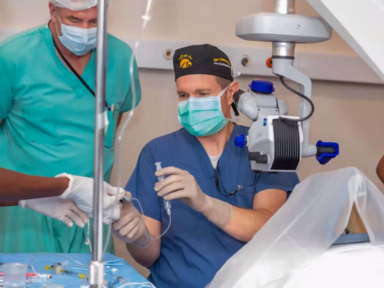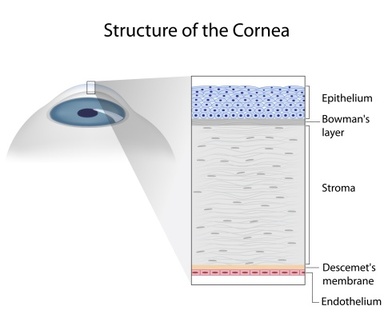
It’s a bright, clear January morning in Sidvokodvothe, Eswatini, approximately 250 miles east of Johannesburg, South Africa. A large group of people have gathered at the tan prescreening building on the Miracle Campus of The Luke Commission, which provides free medical care to some of the kingdom’s most isolated and underserved citizens.
On this morning, Greg Schmidt, Director of Research & Business Development at Iowa Lions Eye Bank (ILEB), is in Eswatini for the first time, assisting patients who are seeking care for various eye-related concerns. Schmidt, who has worked at ILEB for 24 years, says he is doing multiple tasks, and each day is a little bit different.
“The Luke Commission’s philosophy is to start early and stay late to serve every last one,” Schmidt says. “It’s the true essence of compassionate medicine.”
FROM IOWA TO AFRICA
Schmidt was invited to spend a week volunteering in Eswatini in January 2024 by Matthew Ward, MD, a Provo, Utah-based ophthalmologist who is an alumnus of the residency program and cornea and external disease fellowship at the University of Iowa Department of Ophthalmology and Visual Sciences. Dr. Ward is committed to international eye care and regularly donates his services to The Luke Commission to provide free medical and surgical services, including corneal transplants.
Since leaving Iowa, Dr. Ward has continued to receive corneal tissue from ILEB, and often takes corneas recovered by ILEB with him to Eswatini for use in corneal transplants.
Dr. Ward is not the only ILEB-affiliated ophthalmologist who works in Eswatini. Alex Cohen, MD, a Phoenix, Arizona-based ophthalmologist who also completed his residency and fellowship at Iowa, often works with The Luke Commission and utilizes corneal tissue from ILEB as well.
A SPECIAL OPPORTUNITY

Most of the transplants done at the Miracle Campus in Eswatini are full-thickness transplants, where the entire cornea is utilized. However, because of Schmidt’s long experience in processing services, Dr. Ward was able to do one partial-thickness transplant, called a Descemet’s Membrane Endothelial Keratoplasty (DMEK), during the January trip to Eswatini.
The cornea has five layers: the epithelium, Bowman’s layer, stroma, Descemet’s membrane and endothelium, but in a DMEK, just the Descemet’s membrane and endothelium are transplanted into the patient’s eye. The procedure can shorten recovery times and improve visual acuity.
Schmidt says aside from the DMEK transplant, Dr. Ward performed four other full-thickness transplants in Eswatini. He also performed many other ocular procedures, including cataract removals and strabismus corrections.
The day after surgery, patients would have their patches removed.
“It was such a joyous occasion,” Schmidt says. “Men and women were getting up and dancing. It was a pleasure to watch.”
Schmidt says he enjoyed seeing the country and getting to know the wonderful people of Eswatini.
